Findings based on degree days and demonstrated for earthen ponds in subtropical climates
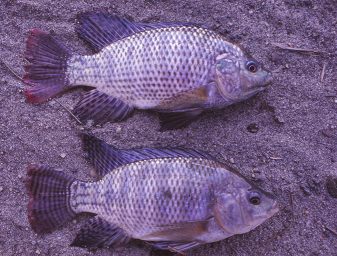
A consistent, reliable supply of fingerlings of the desired species, sex, and size is critical to the success of any aquacultural enterprise. Tilapia production ponds typically are stocked with monosex male Nile tilapia (Oreochromis niloticus. Blue tilapia are grown less commonly than Nile tilapia but may be more appropriate for subtropical regions because of greater tolerance to lower water temperatures.
Harvest of tilapia fry from earthen reproduction ponds is a common method for producing fry suitable for sex inversion. One harvest strategy involves frequent partial harvests whereby schools of swim-up fry are harvested once to six times daily using hand nets or small seines.
Harvest time is based on the assumed reproductive cycle of tilapia. Water temperature varies seasonally and is known to affect fish reproduction and growth. In a study on the production in earthen ponds in the tropics of Nile tilapia fry for sex inversion, Green and Teichert-Coddington (1993) related fry production to cumulative degree days since broodfish stocking and showed optimal production occurred after 195-220 degree days. Degree days are calculated by subtracting a threshold temperature (“biological zero”) from the mean daily temperature; the threshold temperature is the temperature below which development is halted by cold and is not necessarily 0◦C.
Most research on tilapia fry production in earthen ponds is conducted in the tropics, and only one study addressed pond production in the subtropics of tilapia fry for hormonal sex inversion. Our study aimed at quantifying the relationship between cumulative degree days and the production in earthen ponds in a subtropical climate of Nile tilapia (Egypt strain) fry of a size suitable for hormonal sex inversion and to determine if a similar relationship exists for blue tilapia. To be consistent with Green and Teichert-Coddington (1993), we used 15◦C as the threshold temperature for degree-day calculations for Nile and blue tilapia fry production. This article is summarized from the original publication in Journal of Applied Aquaculture, 27:132–143, 2015. This research was a component of the Pond Dynamics/Aquaculture Collaborative Research Support Program funded by the U.S. Agency for International Development.
Study setup
This research was carried out in ten 0.01-ha earthen ponds at the Central Laboratory for Aquaculture Research, Abbassa, Egypt, which is located about 60 km NE of Cairo at 30◦32_ N latitude and has an arid, subtropical climate. Ponds each were equipped with a 6-square-meter concrete harvest basin located in the vicinity of the drain pipe. Average pond water depth was 50 cm; water was added periodically to replace losses to evaporation and seepage. Prior to pond filling, a piece of 1.28-cm square mesh netting was draped over the harvest basin and held in place with rocks. Ponds were filled by gravity using water from a small irrigation canal that originated at the Ismalia canal; each pond inlet was fitted with a saran screen filter to exclude introduction of feral fish. The pond drain pipe was fitted with a 1-mm2 mesh screen. Ponds were left empty between cycles, and any puddles remaining on the pond bottom were treated with granular calcium hypochlorite prior to reflooding.
This research was replicated through time in 26 independent trials (replicates) for each species conducted between April and November. Broodfish for each trial were stocked randomly into one to two ponds, depending upon pond availability. Ponds were harvested 13–20 d after stocking. Female buccal cavities were inspected prior to stocking to ensure none was incubating eggs/sac fry. Broodfish female-male sex ratio was 1.5:1. Nile tilapia broodfish were stocked at 0.9 fish/m2; females averaged (mean +/- SD) 147 +/- 35 g, and males averaged 219 +/- 69 g. Blue tilapia broodfish were stocked at 1.0 fish/m2; females averaged 92 +/- 28 g, and males averaged 170 +/- 48 g. Broodfish were fed a 25 percent protein pelleted commercial ration at 2 percent of fish biomass daily.
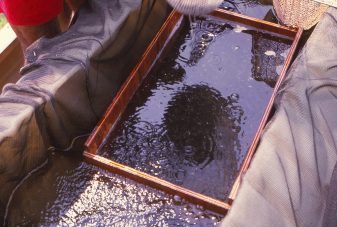
At harvest, the pond water level was lowered until only the sump had water. The netting in the sump was lifted to remove the broodfish en masse; broodfish were transferred to a hauling tank for transport to concrete holding tanks where fish were segregated by sex and held for about 5–7 days until restocking in reproduction ponds. Fry were harvested with dip nets (1.6-mm ace nylon mesh) and graded through 3.2-mm square mesh plastic netting. The number of fry trapped in puddles on the pond bottom or impaled on the drain screen was not estimated. Fry that passed through the grader (target fry) were collected in a 2-m2 hapa (1.6-mm ace nylon mesh) suspended in 28-m2 concrete tanks, and fry number was estimated by visual comparison to a counted standard after manually removing any aquatic insects that were present. Additional details are available in the original publication.
Water temperatures in three ponds were monitored continuously by a computerized data logger; temperature sensors in each pond were mounted at depths of 5 cm and 35 cm. Mean hourly water column temperature was calculated. Degree day was calculated by subtracting the base temperature (15◦C) from the mean hourly water column temperature (Green and Teichert-Coddington 1993). Accumulated degree days for each trial were obtained by summation. Data were analyzed by appropriate statistical tests.
Production of target fry
Cumulative degree days for the 13–20-d trials followed the seasonal trends in mean water column temperature (Fig. 1). Mean daily pond water temperature ranged from 17.7 to 30.2◦C and averaged 27.0 +/- 0.9◦C during these trials. Across all trials there was an average of 211 cumulative degree days (range: 86–281).
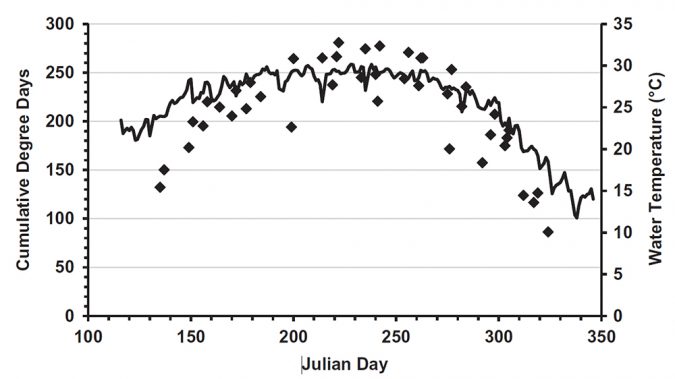
Fry were harvested in all but three trials for each species. The estimated total number of fry harvested from the 26 trials/species was 443,521 and 436,999 for Nile and blue tilapia respectively, of which 79 percent and 74 percent, respectively, were target fry. Coefficients of variation for total fry production (fry/g female) across all trials were 59.1 percent for Nile tilapia and 70.3 percent for blue tilapia. Total fry production per harvest averaged (±SE) 115.5 ± 11.7 and 112.5 ± 11.8 fry/m2 (P = 0.788), and target fry production per harvest averaged 91.5 ± 9.4 and 83.3 ± 9.6 fry/m2 (P = 0.336) for Nile and blue tilapia respectively. Nile tilapia target fry averaged 9.2 ± 0.1 mm TL, and blue tilapia target fry averaged 8.9 ± 0.1 mm TL (P = 0.108), whereas retained fry averaged 14.6 ± 0.3 mm TL and 14.6 ± 0.3 mm TL (P = 0.981), respectively (Fig. 2). Retained fry for both species ranged from 11 to 20 mm TL.
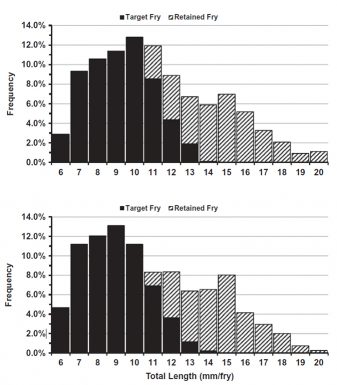
Nile tilapia fry were not observed at fewer than 124 degree days and blue tilapia fry were not observed at fewer than 126 degree days. Females incubating eggs and/or sac fry were observed at harvest, but egg and sac fry numbers were not quantified. Total fry production (fry/g female, y) increased linearly as cumulative degree days (x) increased and was described by the equation y = 0.012x–1.019 (P < 0.001, R2 = 0.461) for Nile tilapia and y = 0.018x–2.016 (P < 0.001, R2 = 0.489) for blue tilapia; covariance analysis indicated that regression line slope did not differ significantly between species.
Production of target fry over the entire range of cumulative degree days (approximately 125–281 degree days) was independent of cumulative degree days for Nile tilapia (P = 0.191, R2 = 0.048) and blue tilapia (P = 0.314, R2 = 0.029). However, target fry production was positively related to increased cumulative degree days over the range 115–215 degree days.
Although target fry production for both species increased linearly as cumulative degree days increased from 115 to 215 degree days, optimal production appeared to occur from 190 to 215 degree days.
Target fry production harvested within 115–190 degree days did not differ (P = 0.861) between species and averaged 0.7 ± 0.2 fry/g female for Nile tilapia and 0.7 ± 0.2 fry/g female for blue tilapia. Nile tilapia target fry production averaged 0.9 ± 0.2 fry/g female when harvested at 115–190 degree days compared to 1.4 ± 0.2 fry/g female for the period 190–215 degree days, but the difference was not statistically significant (P = 0.079). However, blue tilapia fry production was significantly higher (P = 0.020) for the 190–215 degree-days period (1.5 ± 0.2 fry/g female) compared to the 115–190 degree-days period (0.7 ± 0.2 fry/g female). No retained fry were observed for either species between 115 and 190 degree days.
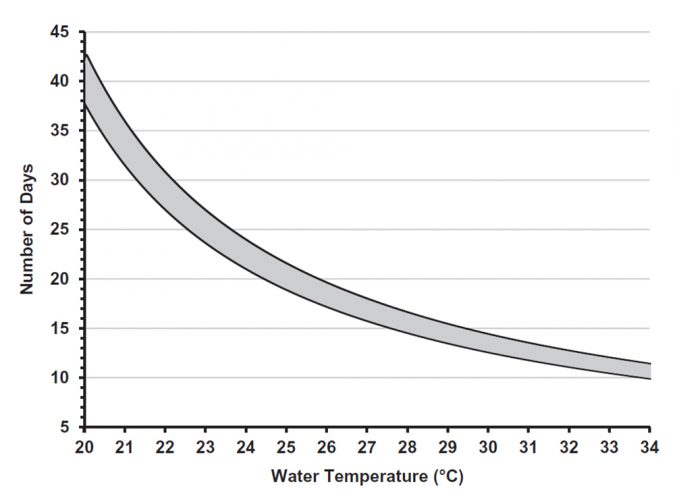
Perspectives
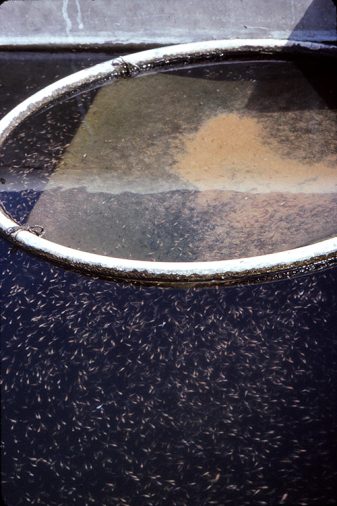
Production of large numbers of Nile tilapia and blue tilapia fry suitable for hormonal sex inversion based on using degree days to set harvest was demonstrated for earthen ponds in a subtropical climate. Both species had similar total and target fry productivities and onsets and peak production periods in terms of cumulative degree days.
Variation in total fry production across all trials in the present experiment was high and was consistent with the variability noted by others. As the cumulative degree days increased, greater numbers of fry exceeded the target fry size range because of the additional time and/or higher temperatures available for growth. More variable fry productivity at higher cumulative degree days could be partially the result of predation on sac fry by larger fry.
Optimal production of Nile tilapia and blue tilapia fry suitable for sex inversion was achieved in the subtropics by harvesting reproduction ponds between 190 and 215 cumulative degree days.
This research showed degree days to be a good predictor for pond production in the subtropics of Nile tilapia and blue tilapia fry for hormonal sex inversion, and confirmed results obtained for Nile tilapia in the tropics. Degree days also would be expected to apply to egg production from spawning hapa-based hatchery operations for tilapia that collect and incubate fertilized eggs, and this research topic would provide additional valuable information for tilapia producers.
Authors
-

Bartholomew W. Green, Ph.D.
USDA-ARS
Harry K. Dupree Stuttgart National Aquaculture Research Center
P.O. Box 1050
2955 Highway 130 East
Stuttgart, AR 72160 USA
[118,111,103,46,97,100,115,117,46,115,114,97,64,110,101,101,114,103,46,116,114,97,98]
-

Esam H. Rizkalla, Ph.D.
Central Laboratory for Aquaculture Research
Agricultural Research Center
Ministry of Agriculture and Land Reclamation
Abbassa, Sharkia, Egypt
[109,111,99,46,108,105,97,109,116,111,104,64,97,108,108,97,107,122,105,114,109,97,115,101]
Tagged With
Related Posts
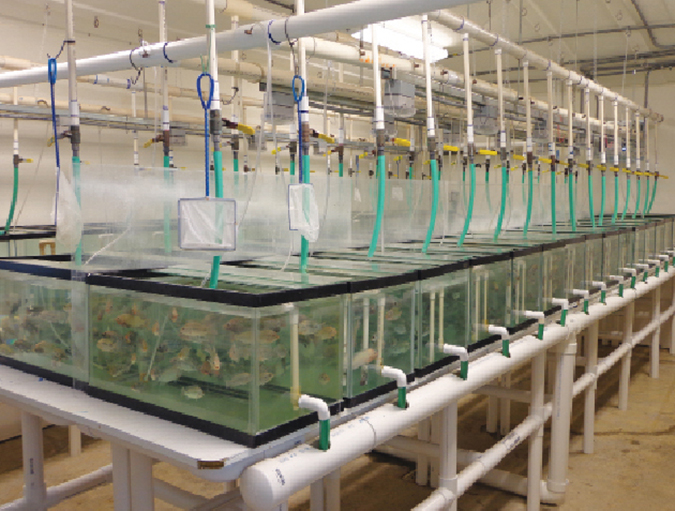
Health & Welfare
Parasite treatment reduces F. columnare infection in tilapia
The authors conducted a study to evaluate whether treatment of Trichodina-parasitized tilapia with formalin would improve fish survival and reduce F. columnare infection. Tilapia not treated with formalin showed significantly higher mortality than treated fish.
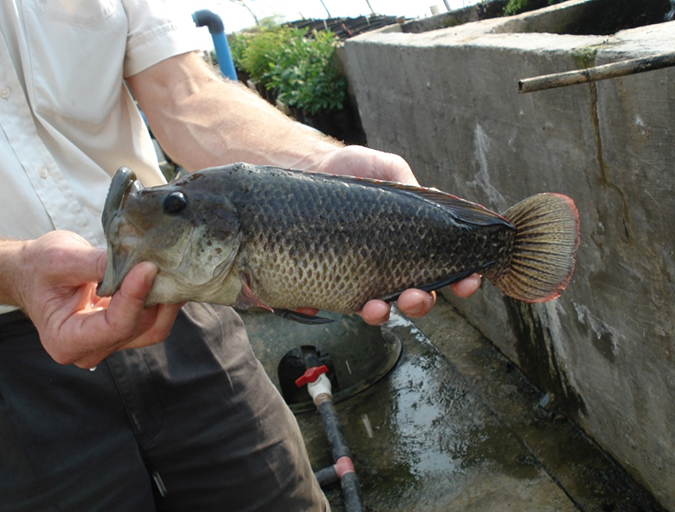
Aquafeeds
Biofloc systems viable for tilapia production
Well-designed and managed biofloc technology systems are a viable alternative for production of various species like tilapia, to increase feed efficiency by lowering aquafeed protein requirements and to help reduce or eliminate effluent discharges.
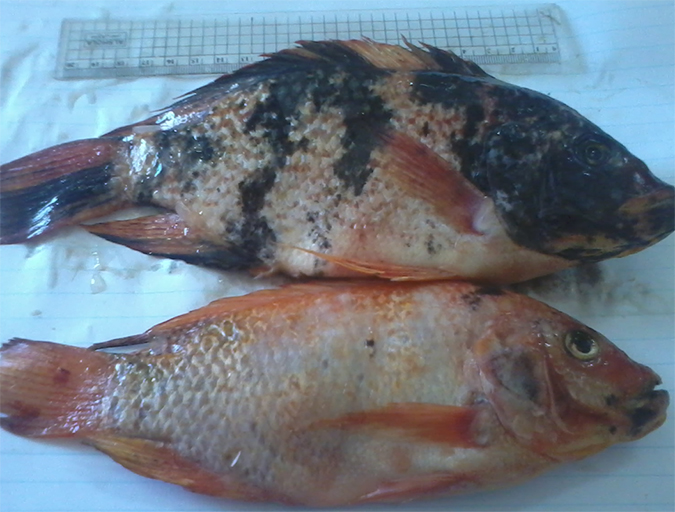
Responsibility
Genetic improvement aids red tilapia growth in Egypt
A new breeding program for genetic improvement of red tilapia was established at the Fish Research Center (FRC), Suez Canal University, in Ismailia, Egypt. It aims to improve the growth rate of the fish and to provide significant benefits to tilapia farmers.
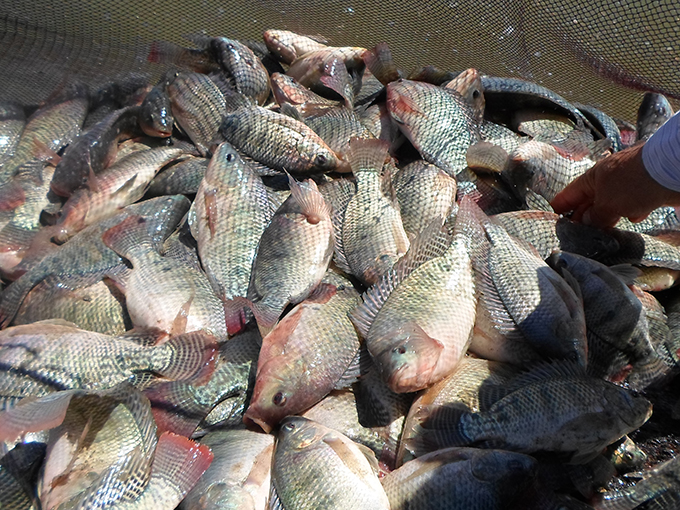
Responsibility
Egypt’s success with tilapia a blueprint for all Africa
Egypt is the third-largest tilapia producer globally, after China and Indonesia, and accounts for about 80 percent of African production of farmed tilapia. Many of the reasons for Egypt’s successful development of its important tilapia industry could be applied to the rest of African continent.

